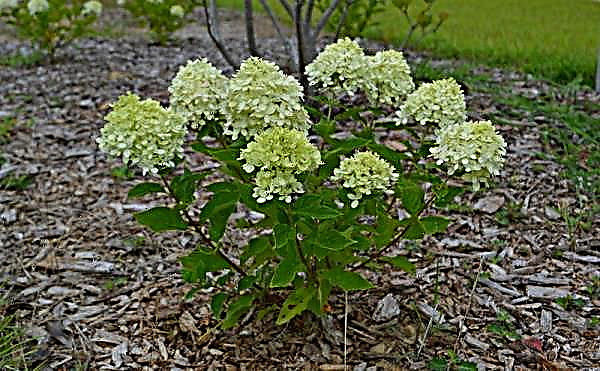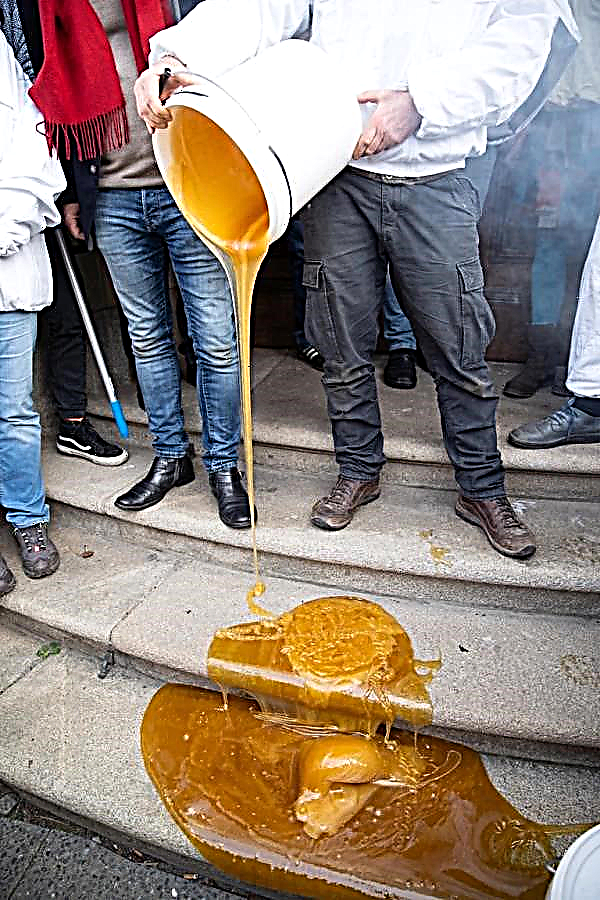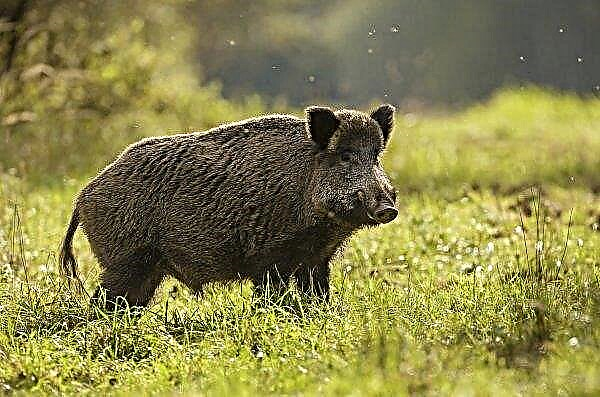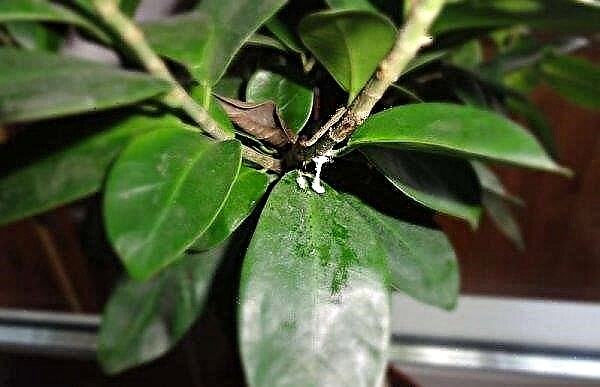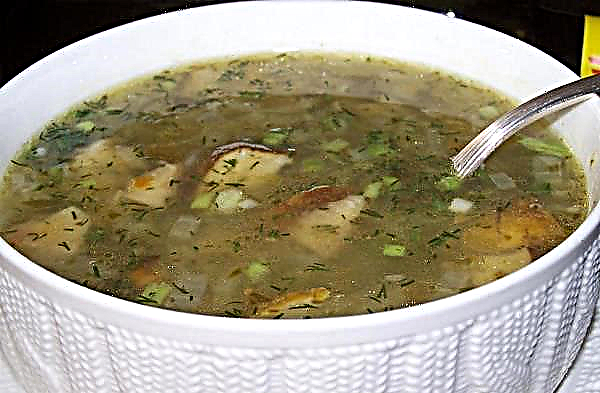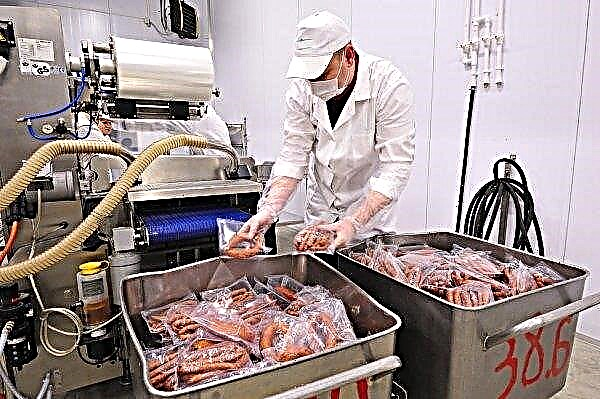When growing dracaena at home, plant breeders often face the problem of leaf fall. This may be a natural process of renewing greenery or the result of improper care. Consider the main mistakes of flower growers, their consequences and ways to resolve problems.
Why do dracaena dry leaves: reasons
The main factors provoking shedding of foliage in dracaena:
- renewal of greenery;
- microclimate violation;
- excess or deficiency of moisture and fertilizers;
- wrong place for growing;
- defeat by diseases and pests.
Did you know? From the juice of dracaena cinnabar receive the resin, which was previously called «dragon blood». It is used in the chemical industry for the production of paints and varnishes.
On average, the dracaena leaf plate has been living and developing for 2 years. When the greens are renewed, the tips of the lower leaves turn yellow and dry. If the leaves themselves do not fall, carefully detach them from the main stem. With improper care, yellowing begins with the top of the plant. In this case, the most important thing is to quickly find the cause and eliminate it.
Disturbed microclimate
When growing dracaena, one should take into account the fact that this plant is tropical, and the indoor microclimate should be as close to natural as possible.
Did you know? Dracaena positively affects the energy of the house and the morale of its inhabitants. It helps calm inner anxiety, relieve nervous tension. In esoteric circles, it is considered a symbol of power and prestige.
The main factors that negatively affect the development of greenery:
- air humidity reduction up to 50-60%;
- temperature conditions below +18 ℃;
- temperature conditions above +27 ℃.

Incorrect fertilizer and watering
Oversupply or lack of nutrients adversely affect the development of plants. The leafy part may develop poorly and fade due to a lack of nitrogen. With its lack, the leaves change shape, acquire a lighter shade and fall off. An excess of this element, combined with abundant watering, leads to an increase in the pH of the soil and decay of the root system.
Often the cause of yellowing is the incorrect conduct of water procedures. Dracaena needs to take a shower periodically or sprinkle it abundantly with water. But after that, it is imperative to drain the sinuses of the leaf blades. The accumulation of water in the sinuses leads to decay, so the foliage turns yellow and dies. A lack of moisture leads to a weakening of the root system, which is externally manifested by the shedding of greenery.
Wrong place to grow
A tropical plant prefers plentiful diffused lighting. Prolonged exposure to direct sunlight leads to burns on the leaves. Dracaenes are poorly developed on the southern window sills and next to heaters that dry the air.
Pests and diseases
Even observing all the rules of care, it is quite difficult to protect yourself from attack by pests and the spread of fungal diseases. Spores of the fungus and insect larvae can be transmitted from a diseased plant to a healthy one or spread during transplantation if the soil mixture has not been properly processed.
Important! When you remove the upper part of the stem, the plant quickly loses moisture. So that the trunk does not dry out, but quickly gives new sprouts, wrap the cut with polyethylene, and spray the trunk with water 2-3 times a day.
Among fungal diseases, dracaena most often develops:
- brown spotting or alternariosis;
- leaf spotting;
- dry spotting.
Of the pests on the leaves of dracaena during home growing can settle:
Brown spotting
The main symptom of alternariosis is oval light brown spots located throughout the surface of the leaf. In the central part of the spots are clearly defined circles of a darker color. After some time, the leaves become covered with a dark coating, consisting of fungal spores, which impedes the normal process of photosynthesis.
Leaf spotting
With an excess of moisture, irregular-shaped spots of a darker shade appear on the leaves than a sheet plate. Sometimes in the central part, fluid can be noted. The disease develops with an excess of moisture.
Dry spotting
The disease affects the leaf plates on both sides. The drying process begins with the apical leaves. First, yellow spots appear, which eventually acquire a darker shade and, drying out, form holes.
What to do and how to treat a plant
When the first symptoms appear, indicating deficiencies in care or a disease, all yellow and dried sheets are removed. Check the condition of the soil, regulate air humidity and temperature.
In order to treat the plants, in each case, drugs of various actions are used:
- fungicides - with fungal diseases;
- insecticides - with the spread of pests;
- acaricides - for treatment from spider mites (do not act on other pests);
- insectoacaricides - for processing from all pests, including spider mites.
With an excess of moisture and fungal diseases, after removing the damaged leaves, the plants need to be transplanted with a complete replacement of the earth coma. After extracting the plants from the pot, the roots are washed, damaged ones are removed. While the root system dries out a bit, you need to sanitize the universal soil for dracaena in the oven and treat it with two fungicidal agents. For example, you can combine Fundazole and Skor. They are bred according to the instructions specified by the manufacturer, and then both solutions are mixed. The concentrate is diluted with water in a ratio of 1: 2, water the substrate and mix it. Subsequent treatments are carried out by spraying the surface of the plant.
For example, you can combine Fundazole and Skor. They are bred according to the instructions specified by the manufacturer, and then both solutions are mixed. The concentrate is diluted with water in a ratio of 1: 2, water the substrate and mix it. Subsequent treatments are carried out by spraying the surface of the plant.
There will be three of them:
- 7-10 days after transplantation - with a solution of Fundazole.
- 5 days after the first - with the Skor solution.
- After another 5 days - a combined solution of the two above drugs.
Important! The drug "Admiral" is incompatible with products containing alkali and malathion.
After the treatment, it is necessary to adjust the care regimen and feed the plants with nitrogen.
Preventive measures
The main preventive measure to prevent leaf fall is proper care, which involves the following rules:
- humidity in the room should be maintained within 80%, at lower rates, increase the frequency of spraying of the leafy part and install a bowl of water next to the plant;
- organization of diffused lighting;
- air temperature at the level of + 20–25 ℃;
- regular removal of dying lower leaves;
- watering only after drying of the top soil layer 1 cm deep;
- fertilizer containing nitrogen and calcium 3 times a season;
- treatment with insecticides when transplanting plants into large containers;
- preventive treatment with fungicides in late summer.

